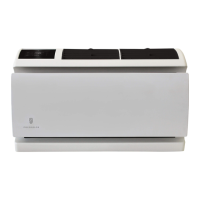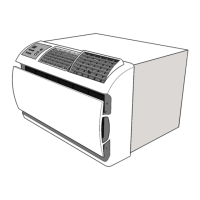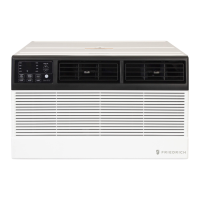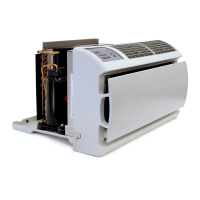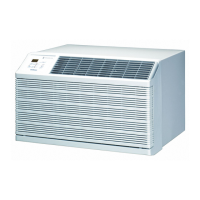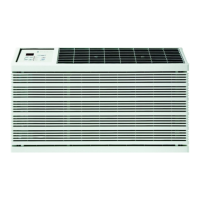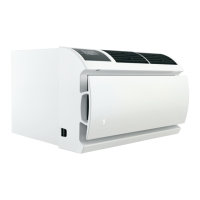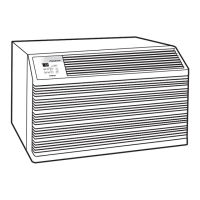Do you have a question about the Friedrich Wallmaster WCT08A10A and is the answer not in the manual?
Details crucial safety procedures, warnings, and hazard symbols for servicing the unit.
Highlights risks of electric shock, burns, and other severe injuries during operation or service.
Covers specific hazards related to refrigeration systems, mechanical parts, fire, and water damage.
Introduces new control features like wireless programming and pre-programmed timer options.
Identifies the location of the unit's model and serial number for service and reference.
Explains the structure and meaning of the unit's model number for identification.
Details how to interpret the unit's serial number to determine its manufacturing date and sequence.
Presents technical data on cooling and heating performance, electrical ratings, and refrigerant charge.
Specifies required clearances around the unit for proper installation and airflow.
Provides information on circuit ratings, power cords, receptacles, and wiring requirements.
Explains how to adjust the direction of airflow from the unit's louvers for optimal comfort.
Details the functions of the unit's control panel, display, and menu navigation.
Describes system modes, fan settings, timer, and other functions accessible via the control panel.
Covers the setup, operation, and effectiveness range of the remote control unit.
Explains cooling operation, condensation, frosting, noises, and heat pump functional differences.
Details the operational sequences for the unit's cooling and various heating modes.
Describes complex heating control for heat pump units, including conditions and automatic switching.
Covers automatic heat, system modes, compressor lock-out, and fan delays for efficient operation.
Explains fan delays, system modes, fan rules, and fan icon details for optimal air circulation.
Explains the four basic principles governing the operation of a refrigeration system.
Provides instructions for removing and installing the front cover and cleaning the air filter.
Guides on cleaning coils, chassis, fan motor, compressor, and blower wheel.
Outlines the steps for safely removing and reinstalling the unit's chassis from the cabinet.
Explains the function and testing procedures for capillary tubes and check valves in heat pump units.
Details how to test the capillary tube assembly for restrictions in cool-only units.
Describes the function and operation of the 4-way reversing valve in controlling refrigerant flow.
Provides steps for testing the reversing valve solenoid coil for electrical continuity and grounding.
Outlines how to check the reversing valve's ability to shift between heating and cooling modes.
A chart correlating valve body temperatures to operating conditions and possible causes.
Details how to check external and internal compressor overloads for proper operation.
Covers testing compressor resistance, ground faults, and checking for efficiency issues.
Provides procedures for testing fan motors and capacitors for proper function.
Explains testing the heating element and the operation of the temperature-sensitive drain pan valve.
Guides on testing the user interface and electronic control board for power and voltage issues.
Describes the four thermistors and how to test their resistance values for proper operation.
Identifies the various components and terminals on the electronic control board.
Step-by-step instructions for safely replacing the electronic control board.
Instructions for removing and replacing the user interface and its ribbon cable.
Provides cooling capacity guidelines and a data sheet for unit performance testing.
Lists diagnostic codes, their corresponding problems, and the control board's actions for each.
Addresses issues like unit not operating, tripping breakers, or frequent cycling with causes and solutions.
Covers problems related to compressor operation, insufficient cooling, and heating performance.
Addresses fan motor failures, dirty filters, and evaporator coil freezing problems with solutions.
Covers electronic control board issues, noisy operation, and compressor vibration problems.
Addresses issues related to water leaks into the room, excessive moisture, and unit cycling.
Discusses problems where the unit cools when heat is called for, or heating is insufficient.
A diagnostic chart for identifying refrigerant system issues during the heating cycle.
A diagnostic chart for identifying refrigerant system issues during the cooling cycle.
Lists critical safety and operational points when working with R-410A refrigerant systems.
Explains the importance of proper charge and methods for charging R-410A systems.
Identifies symptoms and diagnostic methods for undercharged refrigerant systems.
Identifies symptoms and diagnostic methods for overcharged refrigerant systems.
Discusses partial and complete refrigerant restrictions, their symptoms, and diagnosis.
Details the weighed-in charge method for system charging and repair processes.
Provides detailed steps for replacing a compressor, including pre-replacement checks and post-installation.
Outlines special procedures for compressor replacement following a burnout, including system flushing.
Step-by-step instructions for removing and installing a new reversing valve, including brazing precautions.
Shows the electrical connections for cool-only Wallmaster air conditioner models.
Illustrates the electrical connections for Wallmaster heat pump models.
Displays the electrical wiring for Wallmaster models with electric heat.
Describes available optional sleeves and exterior grilles for the Wallmaster unit.
Lists accessories for installation, such as drain kits and baffle adapter kits.
A table listing thermistor resistance values at various temperatures for diagnostics.
Lists authorized parts depots for obtaining replacement components.
Provides contact details for technical support and customer service.
Details crucial safety procedures, warnings, and hazard symbols for servicing the unit.
Highlights risks of electric shock, burns, and other severe injuries during operation or service.
Covers specific hazards related to refrigeration systems, mechanical parts, fire, and water damage.
Introduces new control features like wireless programming and pre-programmed timer options.
Identifies the location of the unit's model and serial number for service and reference.
Explains the structure and meaning of the unit's model number for identification.
Details how to interpret the unit's serial number to determine its manufacturing date and sequence.
Presents technical data on cooling and heating performance, electrical ratings, and refrigerant charge.
Specifies required clearances around the unit for proper installation and airflow.
Provides information on circuit ratings, power cords, receptacles, and wiring requirements.
Explains how to adjust the direction of airflow from the unit's louvers for optimal comfort.
Details the functions of the unit's control panel, display, and menu navigation.
Describes system modes, fan settings, timer, and other functions accessible via the control panel.
Covers the setup, operation, and effectiveness range of the remote control unit.
Explains cooling operation, condensation, frosting, noises, and heat pump functional differences.
Details the operational sequences for the unit's cooling and various heating modes.
Describes complex heating control for heat pump units, including conditions and automatic switching.
Covers automatic heat, system modes, compressor lock-out, and fan delays for efficient operation.
Explains fan delays, system modes, fan rules, and fan icon details for optimal air circulation.
Explains the four basic principles governing the operation of a refrigeration system.
Provides instructions for removing and installing the front cover and cleaning the air filter.
Guides on cleaning coils, chassis, fan motor, compressor, and blower wheel.
Outlines the steps for safely removing and reinstalling the unit's chassis from the cabinet.
Explains the function and testing procedures for capillary tubes and check valves in heat pump units.
Details how to test the capillary tube assembly for restrictions in cool-only units.
Describes the function and operation of the 4-way reversing valve in controlling refrigerant flow.
Provides steps for testing the reversing valve solenoid coil for electrical continuity and grounding.
Outlines how to check the reversing valve's ability to shift between heating and cooling modes.
A chart correlating valve body temperatures to operating conditions and possible causes.
Details how to check external and internal compressor overloads for proper operation.
Covers testing compressor resistance, ground faults, and checking for efficiency issues.
Provides procedures for testing fan motors and capacitors for proper function.
Explains testing the heating element and the operation of the temperature-sensitive drain pan valve.
Guides on testing the user interface and electronic control board for power and voltage issues.
Describes the four thermistors and how to test their resistance values for proper operation.
Identifies the various components and terminals on the electronic control board.
Step-by-step instructions for safely replacing the electronic control board.
Instructions for removing and replacing the user interface and its ribbon cable.
Provides cooling capacity guidelines and a data sheet for unit performance testing.
Lists diagnostic codes, their corresponding problems, and the control board's actions for each.
Addresses issues like unit not operating, tripping breakers, or frequent cycling with causes and solutions.
Covers problems related to compressor operation, insufficient cooling, and heating performance.
Addresses fan motor failures, dirty filters, and evaporator coil freezing problems with solutions.
Covers electronic control board issues, noisy operation, and compressor vibration problems.
Addresses issues related to water leaks into the room, excessive moisture, and unit cycling.
Discusses problems where the unit cools when heat is called for, or heating is insufficient.
A diagnostic chart for identifying refrigerant system issues during the heating cycle.
A diagnostic chart for identifying refrigerant system issues during the cooling cycle.
Lists critical safety and operational points when working with R-410A refrigerant systems.
Explains the importance of proper charge and methods for charging R-410A systems.
Identifies symptoms and diagnostic methods for undercharged refrigerant systems.
Identifies symptoms and diagnostic methods for overcharged refrigerant systems.
Discusses partial and complete refrigerant restrictions, their symptoms, and diagnosis.
Details the weighed-in charge method for system charging and repair processes.
Provides detailed steps for replacing a compressor, including pre-replacement checks and post-installation.
Outlines special procedures for compressor replacement following a burnout, including system flushing.
Step-by-step instructions for removing and installing a new reversing valve, including brazing precautions.
Shows the electrical connections for cool-only Wallmaster air conditioner models.
Illustrates the electrical connections for Wallmaster heat pump models.
Displays the electrical wiring for Wallmaster models with electric heat.
Describes available optional sleeves and exterior grilles for the Wallmaster unit.
Lists accessories for installation, such as drain kits and baffle adapter kits.
A table listing thermistor resistance values at various temperatures for diagnostics.
Lists authorized parts depots for obtaining replacement components.
Provides contact details for technical support and customer service.
| Cooling Capacity | 8, 000 BTU |
|---|---|
| Voltage | 115V |
| Width | 19.5 inches |
| Height | 13.8 inches |
| Depth | 21.5 inches |
| Noise Level | 51/48/45 dBA (High/Med/Low) |
| Cooling Area | 350 sq. ft. |
| EER | 12.0 |
| Operating Frequency | 60 Hz |
| Operating Voltage | 115V |
| Refrigerant | R-32 |
| Type | Through-the-Wall Air Conditioner |
